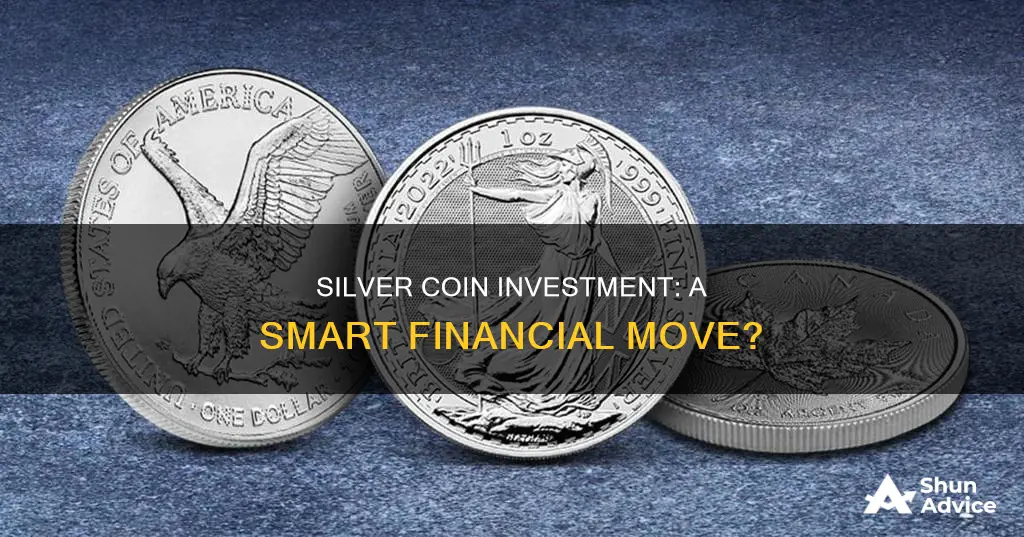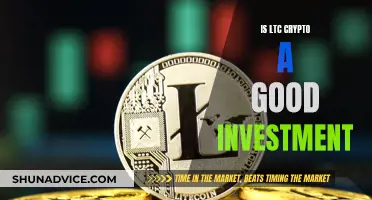
Silver has been a valuable asset to investors for many reasons. It is often used to diversify portfolios, hedge against inflation, and is seen as a safe haven to store wealth. Silver has a long history as a valuable commodity and has been used as legal tender for thousands of years. It is also a tangible asset that can be stored in bullion bars and coins, though this does come with a risk of theft. Silver is also used in industrial applications, such as electronics, automobiles, mirrors, water purifiers, solar panels, and electric vehicles. This industrial demand can help silver act as an inflation hedge, though it also adds an element of volatility to the precious metal. Silver can be purchased in several ways, including physical bullion, silver-backed securities, and exchange-traded funds (ETFs).
| Characteristics | Values |
|---|---|
| Returns | Silver has outperformed stocks over certain periods of time |
| Store of value | Silver can hold its value and even gain value over time |
| Liquidity | Silver is a generally liquid market |
| Less correlated to asset markets | Silver is less correlated to other markets such as stocks |
| Diversification | Silver can act as a way to diversify a portfolio, reducing risks and potentially increasing returns |
| Hedge against inflation | Silver can serve as a good hedge against inflation |
| Portfolio diversification | Silver performs in the opposite way to traditional securities |
| Industrial demand | Industrial demand for silver has been on the rise in recent years |
| Safe haven | Silver is a safe haven against political and economic turmoil |
| Volatile | Silver is volatile, especially over short periods |
| Theft | Physical silver is vulnerable to theft |
| Weaker return on investment | Silver may not perform as well as other investments |
| High demand leads to higher premiums | High demand for physical silver can lead to higher premiums |
| Lack of liquidity | Silver bullion coins are not legal tender |
What You'll Learn

Silver as a hedge against inflation
Silver has long been regarded as a good investment option during tough economic times or periods of severe inflation. As a precious metal, silver has traditionally been a store of wealth and a medium of exchange, making it a good hedge against inflation. Here are some reasons why silver is an attractive investment option during inflationary periods:
Limited Supply and Intrinsic Value
Silver, like gold, has a limited supply and cannot be printed or inflated away by central banks. Its intrinsic value as a physical commodity makes it attractive during inflationary periods when the value of paper currencies declines.
Inverse Relationship with the US Dollar
Historically, the value of the US dollar and the price of silver have an inverse relationship. When the dollar weakens due to inflation or increased money supply, the price of silver tends to rise, making it a good hedge against a declining dollar.
Industrial Demand
Silver has a wide range of industrial applications, including its use in batteries, solar panels, smartphones, and water filtration. The demand for silver in the green energy technology sector, in particular, is expected to increase, which could drive up its price.
Portfolio Diversification
Silver often moves in the opposite direction of traditional securities, making it a good way to diversify a portfolio. When traditional securities fall in value during inflationary periods, silver can help offset those losses.
Affordability and Higher Returns
Silver is much more affordable than gold, making it more accessible to investors. Its lower price also means that it can offer higher returns relative to gold when prices rise.
Long-Term Hedge
Silver has been used as legal tender for thousands of years, and its value has persisted throughout history. This gives investors confidence that silver will retain its value over the long term, even during periods of economic and political turmoil.
Protection Against Inflation
As a physical commodity with intrinsic value, silver can protect investors against the negative effects of inflation. When the economy expands and demand for consumer goods increases, the demand for silver also rises, placing upward pressure on its price and creating a hedge against inflation.
In conclusion, silver is a good investment option during inflationary periods due to its limited supply, industrial applications, portfolio diversification benefits, affordability, and long-term persistence as a store of value.
Etoro's Dogecoin Investment: Is It Worth Your Money?
You may want to see also

Silver as a safe haven asset
Silver is often seen as a safe haven asset, similar to gold. It is a tangible asset that has been used as legal tender for thousands of years, and its value has persisted through mankind's history. Silver is also a hedge against inflation and a store of value.
Silver has a finite supply, and its value is not tied to any currency. This means that its value is free to fluctuate independently of what the dollar does. Silver is also less correlated to other markets, such as stocks, making it a good option for diversifying a portfolio.
Silver has multiple uses, serving as both a precious metal and an industrial metal. It is used in manufacturing various products, including electronics, automobiles, mirrors, water purifiers, solar panels, and electric vehicles.
Silver is also a good investment because of its performance during economic downturns. Investors often flock to precious metals in times of turmoil, and silver has performed strongly in recent years against a background of geopolitical instability and high inflation.
However, investing in silver also has its drawbacks. The most significant risk is its volatility. The silver market is smaller than the gold market, and each dollar of investment in silver represents a larger percentage of its price than gold. This can lead to more considerable price swings, even if the metals are moving in the same direction.
Another risk to consider is the danger of theft. Holding physical silver can leave investors vulnerable to theft, and the more physical assets kept in a home, the higher the risk of losing them in a burglary.
Overall, silver can be a good safe-haven asset to include in an investment portfolio, but it is essential to carefully consider the risks and rewards before investing.
Bitcoin: Invest or Avoid?
You may want to see also

Silver as a diversification tool
Silver is a valuable asset for investors looking to diversify their portfolios. It is a rare, limited-supply commodity that serves as a "safe haven" to store wealth. Silver is also a tangible asset, providing a sense of security for investors who prefer holding something physical over intangible assets such as company ownership.
Silver is often viewed as a diversification tool because it is less correlated to other markets, such as stocks and real estate. This means that silver's performance does not depend on the economic conditions of these asset markets. For example, if global equities are in decline due to worries about instability in a particular region, silver may rise as a safe-haven investment.
Silver is also seen as a hedge against inflation. As a physical commodity, it has intrinsic value. Silver is used in many consumer goods, and the demand for these goods can increase as the economy expands, potentially leading to inflation. Silver's value can also be retained during times of crisis, similar to gold.
There are different ways to invest in silver. One way is to purchase silver bullion, which refers to silver coins or bars. These can be bought from a trusted bullion exchange or local bullion dealers. Another option is to invest in silver funds, such as exchange-traded funds (ETFs), exchange-traded notes (ETNs), or mutual funds, which are correlated to silver's price.
However, investing in silver does come with risks. Silver is subject to the law of supply and demand, which can lead to sharp, unpredictable changes in price. Silver is also vulnerable to theft if held physically.
A Beginner's Guide to Investing in Bitcoin from Florida
You may want to see also

Silver's industrial applications
Silver has a wide range of industrial applications, which account for over half of the annual global demand for the metal. Silver is the best electrical and thermal conductor of all the metals, making it a highly sought-after material for use in electronics and electrical contacts. Its high electrical conductivity and durability mean that it is the perfect substance for coating electrical contacts, like those in printed circuit boards.
Silver is also used in the production of solar panels, where it is used as a conductive ink to transform sunlight into electricity. This application is expected to grow rapidly in the short to medium term. Silver is also used in the automotive industry, with every electrical action in a modern car being activated by silver-coated contacts. Electric vehicles contain between 25 and 50 grams of silver, while hybrid vehicles use 18 to 34 grams. Silver is also used in brazing and soldering, helping to produce smooth, leak-tight, and corrosion-resistant joints when combining metal parts.
Other industrial applications of silver include its use in batteries, dentistry, glass coatings, LED chips, medicine, nuclear reactors, photography, RFID chips, semiconductors, touch screens, water purification, and wood preservatives.
RV Investment: A Safe Haven from Bitcoin's Volatility
You may want to see also

Silver's historical performance
Silver has been a form of money and store of value for over 4,000 years. It was first mined in modern-day Turkey and became a currency in Ancient Greece around 1500 BC. Silver has been used as a standard currency and many countries continue to have silver reserves.
Silver prices tend to rise during economic downturns and periods of high inflation. For example, in 2011, the price of silver reached a 31-year high of $49.21 per ounce due to concerns about monetary inflation and the solvency of governments in the developed world. The price of silver is driven by speculation, supply and demand, and it is influenced by a variety of factors, including industrial applications, jewellery, and bullion coins.
Silver often tracks the price of gold due to store-of-value demands, although the ratio can vary. The gold/silver price ratio is the oldest continuously tracked exchange rate in history. In Roman times, the price ratio was set at 12-12.5:1. In 1792, the ratio was fixed by law in the US at 15:1, and in France in 1803, it was set at 15.5:1. The average gold/silver price ratio during the 20th century was 47:1.
Silver is also influenced by macroeconomic variables such as inflation, GDP growth, and unemployment rates. When interest rates are low, more people invest in silver, increasing its value. During the 2008 financial crisis, the gold Producer Price Index (PPI) increased by 101.1% between 2008 and 2012, while the value of almost all other asset classes decreased.
Silver is also impacted by industrial demand, which has increased in recent years due to its use in renewable energy, textiles, and nanotechnology. In 2010, the majority of silver was used for industry (487.4 million ounces), jewellery (167 million ounces), and investments (101.3 million ounces).
Silver has a long history as an investment and store of value, and its price is influenced by a variety of economic and industrial factors.
Schwab's Bitcoin Investment Options: What You Need to Know
You may want to see also
Frequently asked questions
Silver coins can be a good investment, but like all other investments, it carries risks. It is important to conduct thorough research and map out your investment goals before buying any of this commodity.
Silver coins are often considered a good safe-haven asset, protecting investors in times of turmoil, political or economic. Silver is also a tangible asset, a finite resource that is less likely to crash due to its inherent and real value. Silver is also a cheaper, more flexible investment than gold.
Holding silver bullion can leave investors vulnerable to theft. There is also the risk of a weaker return on investment when compared to other assets such as real estate or even other metals.
You can buy silver coins from local dealers, pawn shops, or online dealers.
A good rule of thumb is to allocate about 5% of your portfolio to commodities as a whole.







